13-8 Titan has a thick atmosphere and hydrocarbon lakes
 Unlike Jupiter, Saturn has only one large satellite that is comparable in size to our Moon. This satellite, Titan, was discovered by Christiaan Huygens in 1665. Titan’s diameter of 5150 km makes it second in size among satellites to Ganymede (Section 13-7). Like Ganymede, Titan has a low density that suggests it is made of a mixture of ice and rock. (See Table 7-2 for a comparison between Titan, the Moon, and the Galilean satellites.) But unlike Ganymede or any other satellite in the solar system, Titan has a thick atmosphere with a unique chemical composition.
Unlike Jupiter, Saturn has only one large satellite that is comparable in size to our Moon. This satellite, Titan, was discovered by Christiaan Huygens in 1665. Titan’s diameter of 5150 km makes it second in size among satellites to Ganymede (Section 13-7). Like Ganymede, Titan has a low density that suggests it is made of a mixture of ice and rock. (See Table 7-2 for a comparison between Titan, the Moon, and the Galilean satellites.) But unlike Ganymede or any other satellite in the solar system, Titan has a thick atmosphere with a unique chemical composition.
Titan’s Atmosphere
By the early 1900s, scientists had begun to suspect that Titan (Figure 13-19) might have an atmosphere, because it is cool enough and massive enough to retain heavy gases. (Box 7-2 explains the criteria for a planet or satellite to retain an atmosphere.) These suspicions were confirmed in 1944, when Gerard Kuiper discovered the spectral lines of methane in sunlight reflected from Titan. (We discussed Titan’s spectrum and its interpretation in Section 7-3.)
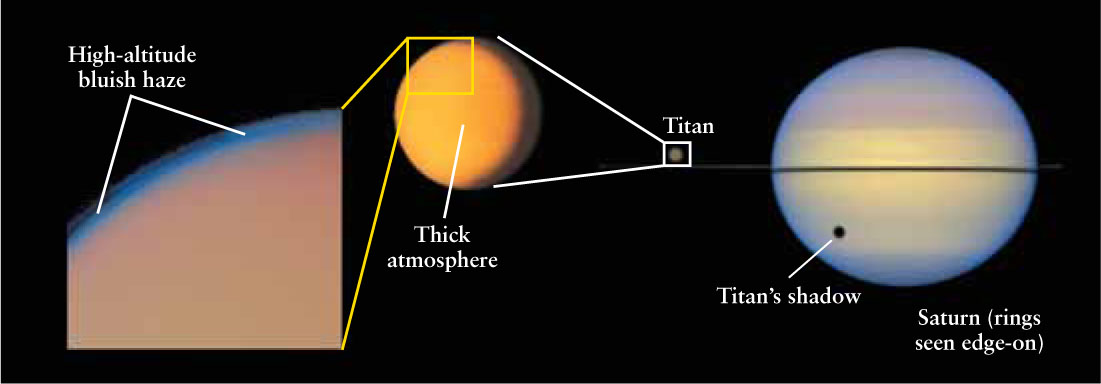
Titan The Hubble Space Telescope image at far right shows Titan and the shadow it casts on Saturn’s clouds. The Voyager image in the middle shows how Titan’s atmosphere gives it a nearly featureless appearance. At far left is a color-enhanced Voyager image that shows a haze extending well above the satellite’s visible edge, or limb.
Because of its atmosphere, Titan was a primary target for the Voyager missions. To the chagrin of mission scientists and engineers, however, Voyager 1 spent hour after precious hour of its limited, preprogrammed observation time sending back featureless images like the one at the center of Figure 13-19. Titan’s atmosphere is so thick—about 200 km (120 mi) deep, or about 10 times the depth of Earth’s troposphere—that it blocked Voyager’s view of the surface. The haze surrounding Titan is so dense that little sunlight penetrates to the ground; noon on Titan is only about 1/1000 as bright as noon on Earth, though still 350 times brighter than night on Earth under a full moon.
By examining how the radio signal from Voyager 1 was affected by passing through Titan’s atmosphere, scientists inferred that the atmospheric pressure at Titan’s surface is 50 percent greater than the atmospheric pressure at sea level on Earth. Titan’s surface gravity is weaker than that of Earth, so to produce this pressure Titan must have considerably more gas in its atmosphere than Earth. Indeed, calculations show that about 7 times more gas (by mass) lies above a square meter of Titan’s surface than above a square meter of Earth. With Titan’s combination of low gravity and thick atmosphere, estimates even suggest that humans could literally fly through the atmosphere by flapping special “wings” attached to their arms!
Voyager data show that more than 95 percent of Titan’s atmosphere is nitrogen gas, although it is not clear where this nitrogen came from. One idea suggests that most of this nitrogen came from ammonia (NH3), a compound of nitrogen and hydrogen that is quite common in the outer solar system. In this scenario, the ammonia is released from Titan’s interior, and then is easily broken into hydrogen and nitrogen by the Sun’s ultraviolet radiation. Titan’s gravity is too weak to retain hydrogen atoms (see Box 7-2), so these atoms escape into space and leave the more massive nitrogen gas molecules behind. However, not all of the details for this scenario fit well with recent Cassini data, prompting another model.
A 2011 experiment at the University of Tokyo indicates that comets smashing into Titan’s surface might have created its nitrogen atmosphere. The experiment had two steps. First, a laser was shot into water-ice that was rich in ammonia. The energy of the laser blast simulates a cometary impact, and the ammonia-rich ice approximates Titan’s crust. Second, measurements were made of the amount of nitrogen gas liberated by the simulated impact. Finally, by assuming the frequency of impacts expected during the Late Heavy Bombardment about 3.9 billion years ago (see Section 8-6), researchers could account for the nitrogen seen in Titan’s present-day atmosphere.
The remaining 5 percent of Titan’s atmosphere is predominantly methane (CH4), which is the principal component of the “natural gas” used on Earth as fuel. However, in the absence of oxygen, Titan’s atmosphere is in no danger of catching on fire. Methane is an example of a hydrocarbon, which is any compound made only from hydrogen and carbon atoms. The interaction of methane in Titan’s atmosphere with ultraviolet light from the Sun produces other hydrocarbons, including ethane (C2H6). As we will see, methane and ethane play a very significant role on Titan beyond its atmosphere.
What gives Titan its reddish-brown color (seen in Figure 13-19)? Nitrogen in Titan’s atmosphere can combine with airborne hydrocarbons to produce other compounds, such as hydrogen cyanide (HCN). Hydrogen cyanide, along with other molecules, can join together in long, repeating molecular chains. Some of these long molecular chains remain suspended in Titan’s atmosphere and might be responsible for its unique color.
Titan’s Methane Cycle
A faint mist of methane rain falls continually on Titan
On Earth, water can be a gas (like water vapor in the atmosphere), a liquid (as in the oceans), or a solid (as in snow and ice). On Titan, the atmospheric pressure is so high and the surface temperature is so low—about 95 K (−178°C, or −288°F)—that any water is frozen solid. But temperatures and pressures on Titan are just right for methane to exist as a gas, liquid, or solid. This single revelation by the Voyager missions—that Titan could support three phases of matter for methane—led to the bold prediction that vapor clouds of methane might rain down onto Titan’s surface to form the only lakes known outside of Earth (Figure 13-20). Are these predictions correct? Does Titan have something analogous to Earth’s hydrologic cycle, with methane playing the role of water? As we will see, the answer is definitely yes!
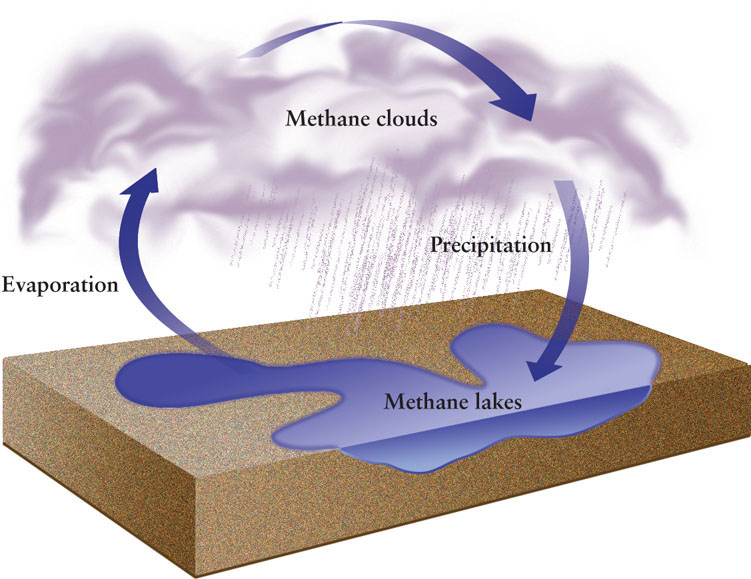
There is one difference though. While Titan’s surface consists mostly of water-ice, methane-ice is only expected at high altitudes in Titan’s atmosphere, where this frozen methane-snow melts to rain before hitting the surface. Even though methane-ice appears to play little role in shaping Titan, it can shape plans for future spacecraft orbits that might want to avoid this methane-snow.
Exploring Titan with Cassini and Huygens
The designers of the Cassini mission to Saturn—which continues until 2017—made the exploration of Titan a central goal. Carried with Cassini was the Huygens probe, which landed successfully on Titan; Huygens was the first landing on any object in the outer solar system. By penetrating Titan’s atmosphere, Cassini and Huygens lifted a veil on the largest unexplored surface in the solar system.
Titan’s atmosphere is more transparent to infrared wavelengths than to visible light, so Cassini has used its infrared telescope to obtain the first detailed images of Titan’s surface (Figure 13-21a). Most of the surface is light-colored, but a swath of dark terrain extends around most of Titan’s equator.
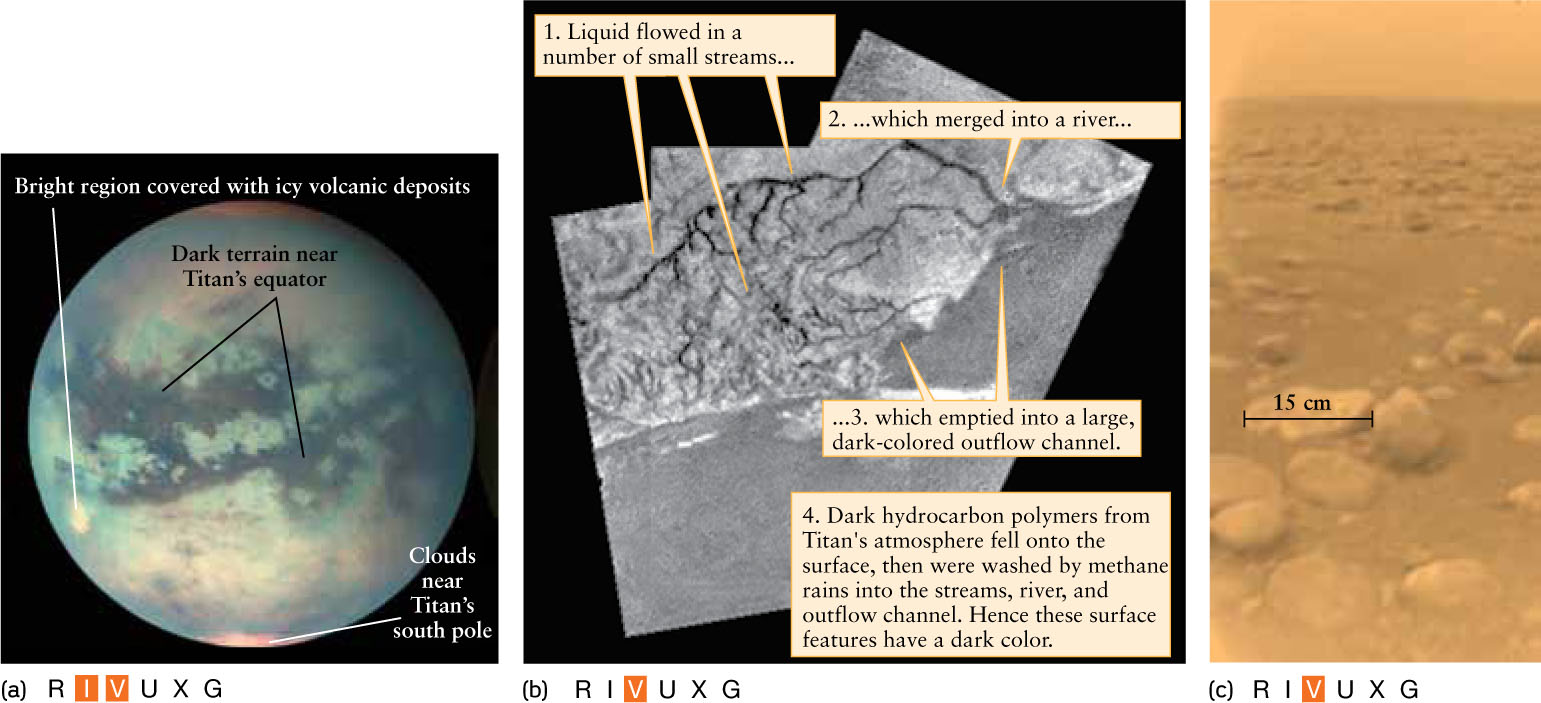

 Beneath Titan’s Clouds (a) This mosaic of Titan was constructed from Cassini images made at visible and infrared wavelengths during a close flyby in December 2005. (b) From 6.5 kilometers high, the descending Huygens lander recorded this view of features on Titan. Carved by flowing liquid, rivers and streams seem to have flowed between ridges about 200 meters high. It is too cold on Titan for water to be a liquid, so these streams and rivers must have carried liquid methane or ethane. (c) This nearly true-color Huygens image shows the view from Titan’s surface. The 15-cm (6-in.) wide “rock” is about 85 cm (33 in.) from the camera. Unlike Earth rocks, Titan “rocks” are chunks of water-ice.
Beneath Titan’s Clouds (a) This mosaic of Titan was constructed from Cassini images made at visible and infrared wavelengths during a close flyby in December 2005. (b) From 6.5 kilometers high, the descending Huygens lander recorded this view of features on Titan. Carved by flowing liquid, rivers and streams seem to have flowed between ridges about 200 meters high. It is too cold on Titan for water to be a liquid, so these streams and rivers must have carried liquid methane or ethane. (c) This nearly true-color Huygens image shows the view from Titan’s surface. The 15-cm (6-in.) wide “rock” is about 85 cm (33 in.) from the camera. Unlike Earth rocks, Titan “rocks” are chunks of water-ice.

Sand Dunes on Titan Unlike sand on Earth, which is made of small particles of silicate rock, sand on Titan is probably made from a mixture of water-ice and organic compounds. The organic compounds give the dark sand their color, which might look like coffee grounds. A mountainous region in the center of this image prevents formation of dunes. Concentrated around the equator, at least 13 percent of Titan’s total surface area is covered in dunes.
Cassini has used its atmosphere-penetrating radar to map the dark terrain. (Like infrared light, radio waves can pass through Titan’s atmosphere.) These images reveal a series of long, parallel lines of sand dunes about 1 to 2 km apart (Figure 13-22). These are aligned west to east, in the same direction that winds blow at Titan’s equator, and so presumably formed by wind action. The dunes can be 100 meters high and stretch for hundreds of kilometers.
The most remarkable images of Titan’s surface have come from Huygens, the small landing craft that Cassini carried on its journey from Earth. Named for the discoverer of Titan, Huygens entered Titan’s atmosphere on January 14, 2005. The lander took 2½ hours to descend to the surface under a parachute, during which time it made detailed images of the terrain (see Figure 13-21b). Chunks of water-ice appear on the surface like rocks (see Figure 13-21c). These are thought to come from the breakup of Titan’s mostly water-ice crust. After touchdown, Huygens continued to return data for another 70 minutes before its batteries succumbed to Titan’s low temperatures.
Huygens images such as Figure 13-21b show that liquids have indeed flowed on Titan like water on Earth. Yet none of the images made by the lander during its descent or after touchdown showed any evidence of standing liquid. However, dampness in the ground detected by Huygens indicates recent methane rainfall or flooding at the landing site.
What would a rainstorm be like on Titan? First, consider that the strength of a downpour on Earth depends on how much water vapor builds up in the atmosphere before larger droplets form and fall as rain. Compared to Earth, measurements indicate that Titan’s atmosphere holds much more moisture before droplets of methane would precipitate out as rain. However, the evaporation rate of methane from Titan’s surface is slower than the evaporation of water into Earth’s atmosphere. As a result, it can take 100 to 1000 years before enough methane builds up to rain down from Titan’s skies. But, when it does rain, so much methane has built up that flash floods are the likely result. The methane raindrops are also expected to be several times larger than the water drops on Earth, and to fall more slowly in Titan’s lower gravity and thicker atmosphere. Grape-sized, slow-falling raindrops are nice to imagine, but keep in mind that they are similar in composition to liquefied natural gas.
Cassini Discovers Vast Lakes
Huygens’ view of Titan was limited to the equatorial region where it landed. While evidence near the equator pointed to the presence of liquid in the past, it took Cassini’s radar maps of the poles to find present-day liquid on Titan. The radar maps (Figure 13-23) have revealed the first standing bodies of liquid in the solar system beyond Earth. The terrain includes vast lakes that are most likely methane and ethane. If correct, evaporation from these large reservoirs could help explain how Titan’s atmosphere contains so much methane even though ultraviolet sunlight breaks it apart.
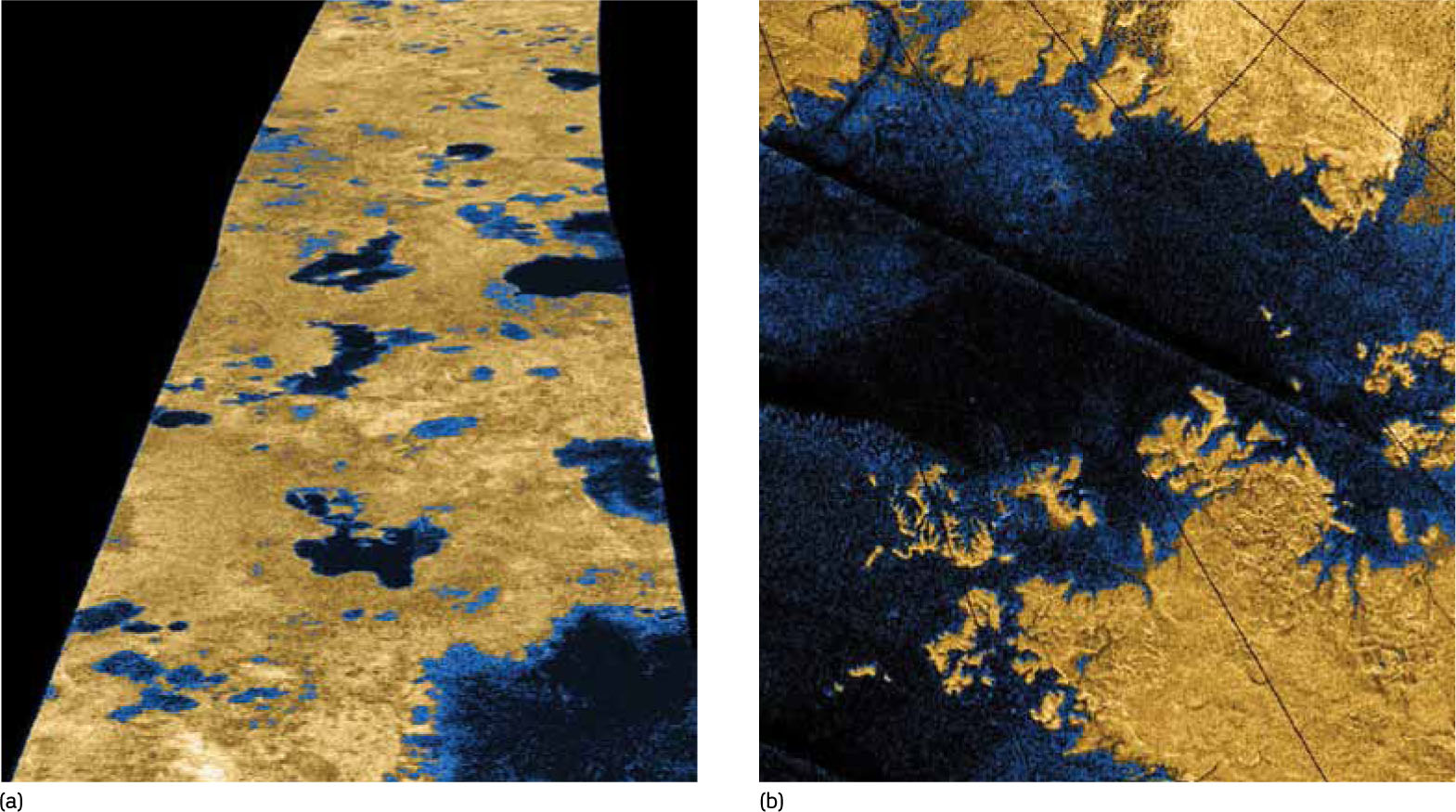
Hydrocarbon Seas on Titan Cassini used its onboard radar to record these false-color views of the region near Titan’s north pole. (a) The dark regions show where the surface does not reflect radio waves at all, which leads to the interpretation that these are flat lakes (presumably filled with liquid methane and ethane). (b) Lake Ligeia Mare is one of the larger lakes and is about the size of Lake Superior (about 350 miles wide). In this high resolution image, many tributaries can be seen around the lake’s perimeter.
How Titan’s lakes were discovered is more subtle than the images imply. To analyze Titan’s terrain through its atmosphere, radar waves are reflected like echoes off its surface. This works for imaging typical surfaces with mountains and canyons, but very flat surfaces reflect radar at only one angle—like a ball bouncing off a wall—and no radar echo is returned (except when Cassini is directly overhead). Therefore, Titan’s lakes are inferred by their flatness: They are surface regions where very little radar echo is detected. In fact, the measurements are so precise that the lakes present another mystery: They are too flat.
Most large lakes have wind-driven waves, and with Titan’s thick atmosphere and low gravity, wind is expected even at the poles. Indeed, we mentioned that near the equator, windblown sand dunes can reach 100 meters in height, and stretch for hundreds of kilometers (see Figure 13-22). Thus, the flatness of the polar lakes remains a mystery.
Overall, there are many more lakes near Titan’s north pole than its south pole. Why? Titan’s northern hemisphere is currently in its winter season. Since lower temperatures lead to more condensation, more lakes are expected. Over the course of a Titan year (which lasts 29.37 Earth years) the supply of liquid will migrate with the seasons from pole to pole, much as frozen carbon dioxide migrates seasonally on Mars (see Section 11-6).
More than the seasons however, it is expected that an even larger effect accounts for a long-term predominance of lakes in the north. Due to the shape of Saturn’s orbit around the Sun, during the Titan summer the entire Saturn-Titan system is 12 percent farther from the Sun than during the winter, making Titan’s north cooler, on average, than the south. Over long timescales, when you consider the combined orbital properties of Saturn and Titan, lakes are expected to predominate at one pole or another for about 32,000 years before reversing, and we just happen to be in a northern part of that cycle.
Cryovolcanoes on Titan?
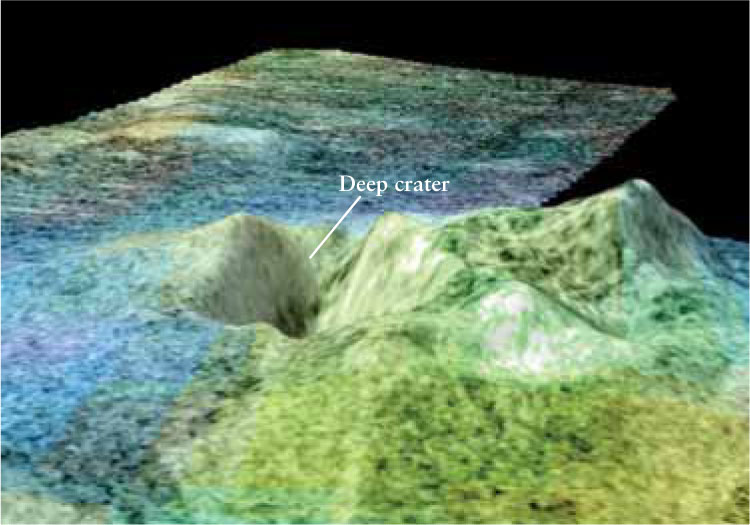
Cryovolcanism The Sorta Facula region contains Titan’s best candidate for a cryovolcano made of water-ice. Some of the taller peaks are more than 1,000 meters high, next to a deep 1,500-meter volcanic crater. There are also examples on Earth where a crater is deeper than the height of the volcano. At the moment, the cryovolcano does not appear to be active. The blue areas in this false-colored radar map are thought to be exposed water-ice, with other colors possibly due to a thin layer of organic compounds covering water-ice.
Combining infrared and radar images, Cassini also detected surface features that indicate a cryovolcano (Figure 13-24). Instead of erupting molten rock, a cryovolcano (or ice volcano) on Titan is expected to erupt or ooze icy mixtures of water, ammonia, and methane. Acting as an “antifreeze,” the ammonia (NH3) is key, and it allows the mixture to remain a liquid within Titan’s interior. This picture is quite consistent, as the ammonia (broken down by ultraviolet sunlight) was already expected as the source of Titan’s atmospheric nitrogen.
In addition to evaporation from lakes, the presence of ice volcanoes on Titan can explain why there is so much methane in the satellite’s atmosphere. Methane molecules are broken apart by ultraviolet photons from the Sun, and the hydrogen atoms escape into space. This process would destroy all of Titan’s methane within 10 million years unless a fresh supply is added to the atmosphere, perhaps aided by cryovolcanoes. While entirely fascinating, Titan’s cryovolcanism isn’t entirely unique: We’ll see in Section 13-10 that another moon of Saturn (Enceladus) shows ongoing cryovolcanism.
CONCEPT CHECK 13-9
Explain two roles that ammonia (NH3) seems to play on Titan; one role on or above the surface, and one below.
Ninety-five percent of Titan’s atmosphere is nitrogen, which is thought to come from either ultraviolet sunlight breaking down ammonia or comet impacts generating nitrogen from ammonia. Ammonia in water also lowers the temperature at which that water will freeze, and this allows water below the surface to act like lava in cryovolcanoes.
Titan’s Geology
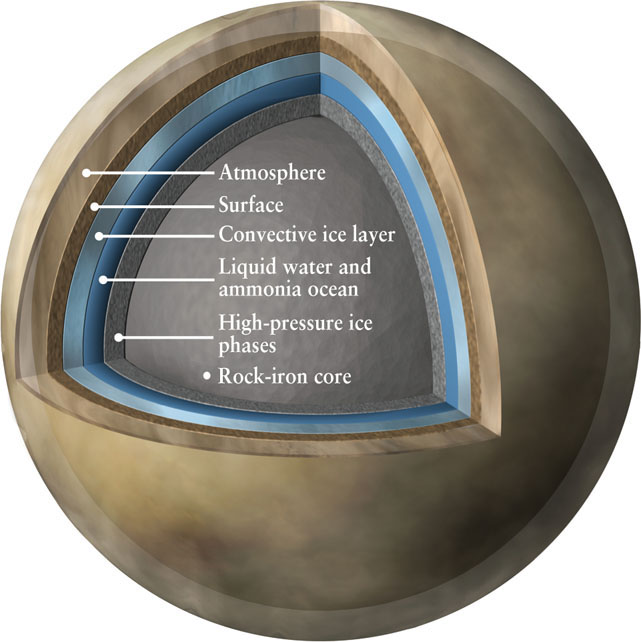
There are some indications that Titan might have a subsurface ocean of liquid water. Electrical measurements made by Huygens are consistent with the top of such an ocean about 45 kilometers beneath the surface. Furthermore, models with a subsurface ocean might provide a better fit, compared to a solid body, for Titan’s carefully measured shape and gravitational field. However, due to Titan’s atmosphere, Cassini cannot orbit closely enough to make the additional magnetic field measurements that would more clearly reveal a subsurface ocean on Titan. Why is water so interesting? As we will see in Chapter 27 on the search for extraterrestrial life, liquid water either in a subsurface ocean or associated with cryovolcanoes means that Titan could be habitable to simple forms of life.
The predicted interior of present-day Titan is shown in Figure 13-25, but what was Titan like in the past? We have seen that Titan was probably volcanically active to provide its atmosphere with methane, but what has powered the volcanic activity? Titan is too small to have retained the internal heat from its formation. Furthermore, although Titan’s rotation is synchronous like that of Io, its orbit around Saturn is so circular that it cannot be heated by tidal flexing in the way that Io is (see Section 13-4).
One model to power cryovolcanism proposes that about 500 million years ago, the last of Titan’s internal heat from radioactivity caused convection to take place in the satellite’s icy crust. The resulting ice volcanoes would repave the entire surface, explaining Titan’s unexpectedly low crater density. The amount of methane released during this proposed episode is enough to sustain the gas in the atmosphere, but—very importantly—not necessarily enough to create the extensive hydrocarbon lakes. Thus, we have much to learn about Titan’s present condition, as well as its past.
What already seems clear from the data is that the early predictions were correct: Titan’s methane does indeed take liquid and gas forms, producing a cycle similar to water’s hydrological cycle on Earth. With its storms, lakes, and volcanoes, Titan is a truly fascinating world.
CONCEPT CHECK 13-10
If lakes were not found in images made by the Huygens probe, and Cassini cannot see through Titan’s thick haze, how were lakes discovered?
Cassini discovered lakes using radar. By reflecting radio waves, radar can be used to map the height of surface features. The lakes show up as very flat regions, and tributary channels support this interpretation.
CONCEPT CHECK 13-11
What insight from Voyager data led scientists to predict that Titan’s methane might be involved in a cycle similar to Earth’s hydrological cycle?
Voyager found that temperatures and pressures on Titan are just right for methane to exist as a gas, liquid, or solid. Titan’s methane cycle depends on these changes between liquid and gas, just as Earth’s hydrologic cycle depends on changes between liquid and gas phases of water.